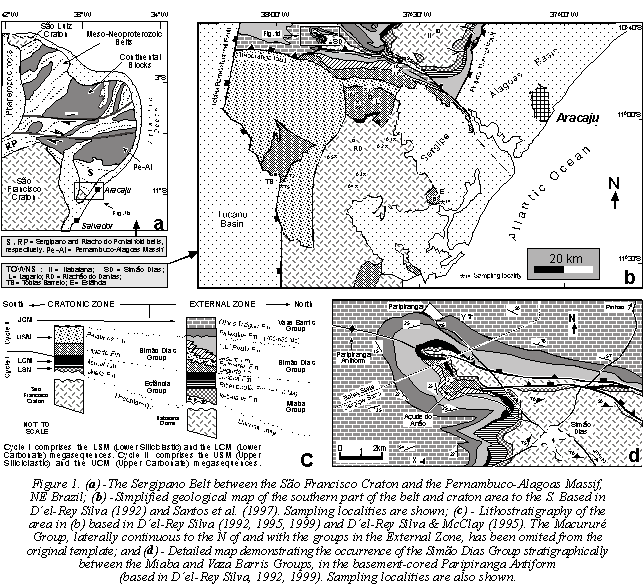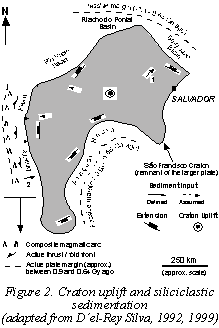 |
Luiz José Homem D´el-Rey Silva Brasília – DF, Brazil. ldel-rey@unb.br
ABSTRACT The detailed tectonic analysis carried out (1992) in the Sergipano Belt (SB) and in the adjacent São Francisco Craton (SFC), of NE Brazil, further confirmed by field/laboratory research upon an expanded area (1993-1999) resulted in that the Meso-Neoproterozoic lithostratigraphic units resting on the crystalline basement are actually craton-belt continuous, and the lithostratigraphic template erected at that time brought to light the participation of the craton as the source area for the upper siliciclastic formations in the study area. These results are here checked against new Sm-Nd data from the same rocks previously studied, as well as Sm-Nd and U-Pb data from the Arauá igneous dykes in the craton. The new data confirm the previous results and, combined with other data in recent, independent, and pertinent literature, they also allow to state safely, again, that the progressive uplift of the SFC played a key role in the evolution and infilling of the rim of the Meso-Neoproterozoic basins, as predicted in the original analysis. Although needless and difficult to reconcile with other geology data, the joint participation of the Marancó and Canindé arcs as source areas is not ruled out, solely to justify the Sm-Nd data. A third possibility, also discussed, is even harder to accept.
Key-words: São Francisco Craton, Sergipano Belt, Sm-Nd data, U-Pb age, provenance studies
LITHOSTRATIGRAPHIC IMPLICATIONS The SB lies between the edge of the SFC and the Pernambuco-Alagoas Massif, NE Brazil (Fig.1a) and displays a passive margin-like lithostratigraphic record laterally continuous with the sedimentary cratonic cover to the S, accross the craton-belt boundary fault (the positively inverted Itaporanga fault, Fig.1b; D´el-Rey Silva, 1992). The crystalline basement of the Paleoproterozoic-Archean craton is also the core of the Simão Dias and Itabaiana gneiss domes of the belt (Fig.1b). A detailed lithofacies / lithostructural mapping, aided by geophysical survey, carried out upon a 4000km2 area spreading from the domes onto the craton, resulted in a comprehensive tectonic analysis that compelled to the reorganization of the SB lithostratigraphy (D´el-Rey Silva, 1992, 1995; D´el-Rey Silva & McClay, 1995) and basin infilling became understandable in terms of two cycles and four megasequences of a tectonically controlled sedimentation (Fig.1c). In Cycle I, the LSM - conglomerate, sandstone, quartzite (the basal Juetê and Itabaiana formations) and also (meta)argillites, phyllites, diamictites, and volcanics (top of the Juetê Fm and its lateral equivalent, the Ribeirópolis Fm) plus the LCM - the Acauã-Jacoca carbonate formation. Cycle II comprises: the USM - basal argillite, siltstone, and fine-grained sandstone (Lagarto Fm) and fine- to coarse-grained sandstone, and greywacke (Palmares Fm) both craton-belt continuous and passing laterally into the Jacaré Fm metasiltite and Frei Paulo Fm phyllite, towards the belt, in which the group is covered by the Palestina Fm diamictite, plus the UCM – the carbonate megasequence corresponding to the Olhos D’água Fm. The record of Cycle I is divided into the basal Estância-Miaba groups, whereas that of Cycle II is divided into the Simão Dias Group and into the Vaza Barris Group. Such lithostratigraphic record passes gradually into the distal Macururé Group (basal quartzites, schists, phyllites, volcanics) of the Internal Zone of the belt (same authors as above). Further research (1993-1998) in the original dome-craton area, and also to the S of it, entirely confirmed the lithostratigraphy and provided a ~810Ma U-Pb age for Ribeiróplis volcanics, a good support for the correlation between diamictites of the upper Juetê-Ribeirópolis and Jequitaí-Canabravinha Fm (lower Bambuí Group). The Simão Dias Group (= middle to upper Bambuí Group) records a coarsening upwards siliciclastic sedimentation fed from the craton that was experiencing progressive uplift (D´el-Rey Silva, 1992, 1999). The tectonic significance of the Palestina diamictites and the <700Ma U-Pb age for the correlative diamictites in Africa (Germs, 1995, also referred in D´el-Rey Silva, 1999) both fit very well in this scenario. Such results are checked once more, herein, against new isotope data from samples of rocks of the SB analyzed (2000-2002) in the Laboratory of Geochronology, University of Brasília.
Sm-Nd (and U-Pb age) DATA Table 1 displays the Sm-Nd data for 22 samples collected in the most typical localities, being 17 samples from all siliciclastic lithostratigraphic units of the southern part of the SB and cratonic cover (unless the Juetê Fm) and for 5 samples of the Arauá dyke swarm (around Riachão do Dantas; Fig.1b). TDM ages of 9 samples of Lagarto and Palmares rocks far into the craton span from 1484My to 1950My. The TDM data for siliciclastic metasediments around the basement domes (Fig.1b), particularly in the core of the Paripiranga antiform (Fig.1d) indicate: 1 – Ages for the Itabaiana quartzite (DFS9/02) and the Palestina diamictite (DFS 6/02) are respectively 2745My and 2345My; and 2 – Ages for Ribeirópolis, Lagarto, Palmares, Jacaré, and Frei Paulo rocks span from 1612My to 2067My, much in agreement with the data for Lagarto and Palmares rocks in the craton. TDM ages for the dykes lie in the 2695My-3176My interval. The values of ε(0) are negative enough to leave no doubt that the studied rocks derive all from a mixture of sources that include material of the continental crust.
The TDM ages imply that: 1 – The Itabaiana Fm requires solely Archean sources; 2 - The Ribeirópolis Fm and all the rocks of the Simão Dias Group display the same Sm-Nd pattern and TDM ages in the 1612-2067My interval. The data for the Simão Dias Group clearly agree with the fact that the Lagarto and Palmares formations are laterally and vertically continuous in the field, and pass gradually to the Jacaré and Frei Paulo formations; 3 – All these rocks require sources with Archean /Paleoproterozoic TDM ages as well as sources with TDM ages <1400My; 4 – The Palestina Fm requires Archean and Paleoproterozoic sources, but the contribution of sources with TDM ages <1400My also sounds well; 5 – The Sm-Nd data fully reinforce the lithostratigraphic findings and their consequences (D´el-Rey Silva, 1992, 1995; D´el-Rey Silva & McClay, 1995); and 6 – The Arauá dykes and any eventually related volcanism are not the sources capable to low the Ribeirópolis – Simão Dias TDM ages. To date, clean zircons selected from sample A3/02 yielded the U-Pb crystallization age of 1990±27My for the Arauá dykes.
Table 1. Sm-Nd data for siliciclastic rocks in the External and Cratonic zones of the Sergipano Belt, and also for some dykes of the Arauá swarm. Samples of siliciclastics are organized vertically according to the stratigraphic position of the formations from which they come from. Labels /00 and /02 stand for samples collected in 2000 and 2002, respectively.
DISCUSSION The sources with TDM age <1400My required to explain the Sm-Nd data (apart from the Itabaiana Fm) may well have been part of the SFC itself, particularly the 1000My old mantle plume-derived radial dyke swarm found just about the Bahia-Congo connection (Correa Gomes & Oliveira, 1997; D´Algrella Filho et al., 2004) and possibly related volcanic rocks. Basic and juvenile Neoproterozoic magmas found in the basal section of basins are commonly reworked during progressive extension and may well contribute to the sedimentation of upper siliciclastic formations, as it seems to be in Pan-African/Brasiliano belts of Africa (e.g. Leblanc & Moussini-Pouchkine, 1995). This is very much the case in the basin precursor to the Sergipano Belt, inside which the Ribeirópolis Fm volcaniclastics contain clean zircons aged 810M. Pedrosa Soares et al. (2000) related <1000My old detrital zircons they found in basal diamictites of the Macaúbas Group (= Bambuí Group) of the Araçuaí Belt to sources that include the Salvador-Congo radial dykes, as well as mafic volcanics reported in the Espinhaço Range, whereas Valeriano et al. (2004) described detrital zircons in the cratonic cover adjacent to the southern part of the Brasília Belt, and related them to ~1300My old juvenile material likely existing somewhere in the buried margin of the former plate. The discussion above leaves clear that the SFC is the source area that satisfactorily answers the questions on provenance in the SB. This fact does not preclude, however, that Meso-Neoproterozoic juvenile rocks existing in the Canindé and Marancó arcs, to the N of the passive margin-like Sergipano Basin between 1.1 to 0.65Gy ago (Fig.2), could have contributed as well. This contribution is totally dispensable, however, and cannot be demonstrated with the currently available inventory of geology data. In order to become valuable for future synthesis on the tectonic evolution of the SFC-SB system, the idea demands much more specific studies, including those on paleomagnetism. It could be also speculated that the siliciclastics of the SB, including the Macururé Group, would have been all deposited in a kind of foreland basin developed to the S of a collision-type orogen established since before 810My ago. This hypothesis must be rejected because it hardly copes with the Archean TDM age of the Itabaiana Fm and just turns upside-down all the models envisaged for the tectonic evolution of the SB, without a single support other than the TDM ages.
CONCLUSIONS The new Sm-Nd data presented in this paper confirm the lithostratigraphy of the Sergipano Belt and also support the idea that (D´el-Rey Silva, 1992), apart from the additional contribution of the juvenile material from the Neoproterozoic Goiás Magmatic Arc (Pimentel & Fuck, 1992) adjacent to the Brasília belt, the upper siliciclastic formations in the sedimentary cover of the São Francisco Craton derive from cratonic sources (Fig.2). The uplift matches all geology data of the craton itself and also of the Meso-Neoproterozoic cratonic cover, including also the Proterozoic tectonothermal evolution interpreted from K-Ar data (Teixeira & da Silva, 1993) and several other information as already summarized in D´el-Rey Silva (1999). Further studies on the Sm-Nd pattern for the Macururé Group and on detrital zircons all over the lithostratigraphic column will lead to a more detailed understanding on the provenance of the siliciclastics of the Sergipano Belt, and on the role of any other source area beyond those existing in the São Francisco Craton since the time of basin infilling.
ACKNOWLEDGEMENTS FINATEC – UnB (2005) is thanked for supporting my participation in this Symposium. Thanks to Manuela, my daughter, for editing.
REFERENCES Correa-Gomes, L.C.
& Oliveira, E.P. 1997. O enxame radial de diques máficos da Província
Bahia-Congo. Implicações reológicas e tectônicas na presença de uma
pluma mantélica na interface América do Sul-África, 1,0Ga atrás. In:
SBG, VI SNET, Pirenópolis-GO, Brasil, Anais, pp.52-55. D´Algrella-Filho,
M.S.; Pacca, I.I.G.; Trindade, R.I.F.; Teixeira, W.; Raposo, M.I.B.;
Onspott, T.C. 2004.
Paleomagnetism and 40Ar/39Ar
ages of mafic dikes from Salvador (Brazil): New constraints on the
São Francisco APW path between 1080 and 1010Ma. Precambrian Research,
132(1-2): 55-77. D´el-Rey Silva,
L.J.H. 1992. Tectonic evolution of the southern part of the Sergipano Fold Belt, northeastern
Brazil. Unpublished PhD Thesis, Royal Holloway University of
London, England, 257p. D´el-Rey Silva,
L.J.H. 1995. The evolution of basement. Gneiss domes of the Sergipano
fold belt (NE Brazil) and its importance for the analysis of Proterozoic
basins. Journal of South Ame. E. Sci., 8 (3/4): 325-340. D´el-Rey
Silva, L.J.H. 1999. Basin infilling in the southern-central part of the
Sergipano Belt, NE Brazil, and implications for the tectonic evolution
of the Pan-African/Brasiliano cratons and Neoproterozoic sedimentary
cover. Journal of S.outh America Earth Sciences ,12(5): 453-470. D'el-Rey Silva, L.J.H. & McClay, K.R. 1995. Stratigraphy of the southern
part of the Sergipano Belt, NE Brazil: Tectonic implications. Revista
Brasileira de Geociências, 25(3): 185-202. Germs,
G.J.B. 1995. The Neoproterozoic of southwestern Africa, with emphasis
on platform stratigraphy, and paleontology. Precambrian Research,
73: 137-151. Leblanc,
M & Moussini-Pouchkine, A. 1995. Sedimentary and tectonic evolution
of a Neoproterozoic continental margin (Bleida, Anti-Atlas, Morocco).
Precambrian
Research, 70: 25-44. Pedrosa
–Soares, A.C.; Cordani, U.G.; Nutman, A. 2000. Constraining the age
of Neoproterozoic glaciation in Eastern Brazil: First U-Pb (SHRIMP)
data of detrital zircons. Rev.
Bras. de Geoc. 30, 058-061. Pimentel, M.M. and
Fuck, R.A. (1992). Neoproterozoic crustal accretion in Central Brazil, Geol.ogy,
20: 375-379. Santos, R.A. dos;
Martins, A.A.M.; Neves, J.P. das; Leal, R.A. 1997. PLGB - Geologia
e Recursos Básicos do Estado de Sergipe. Brasília, CPRM: CODISE, 156p. Silva Filho, M.A.
da; Bonfim, L.F.C.; Santos, R.A. dos 1977. Projeto Baixo São Francisco
/ Vaza Barris: Geologia da geossinclinal Sergipana e do seu embasamento.
CPRM, Salvador, Relatório Final, 19 volumes. Teixeira, W. and Silva, F.C. da (1993). A evolução tectonotermal proterozóica do Cráton São Francisco, com base em interpretações geocronológicas K-Ar. SBG Simpósio do Cráton São Francisco 2, Salvador, Anais, 18-20. Valeriano, C. de M.; Machado, N.; Simonetti, A.; Valladares, C.S.; Seer, H.J.; Simões, L.S. de A. 2004. U-Pb geochronology of the southern Brasília belt (SE-Brazil): sedimentary provenance, Neoproterozoic orogeny and assembly of West Gondwana. Precambrian Research, 130 : 27-55.
|
||||||||||||||||||||||||


